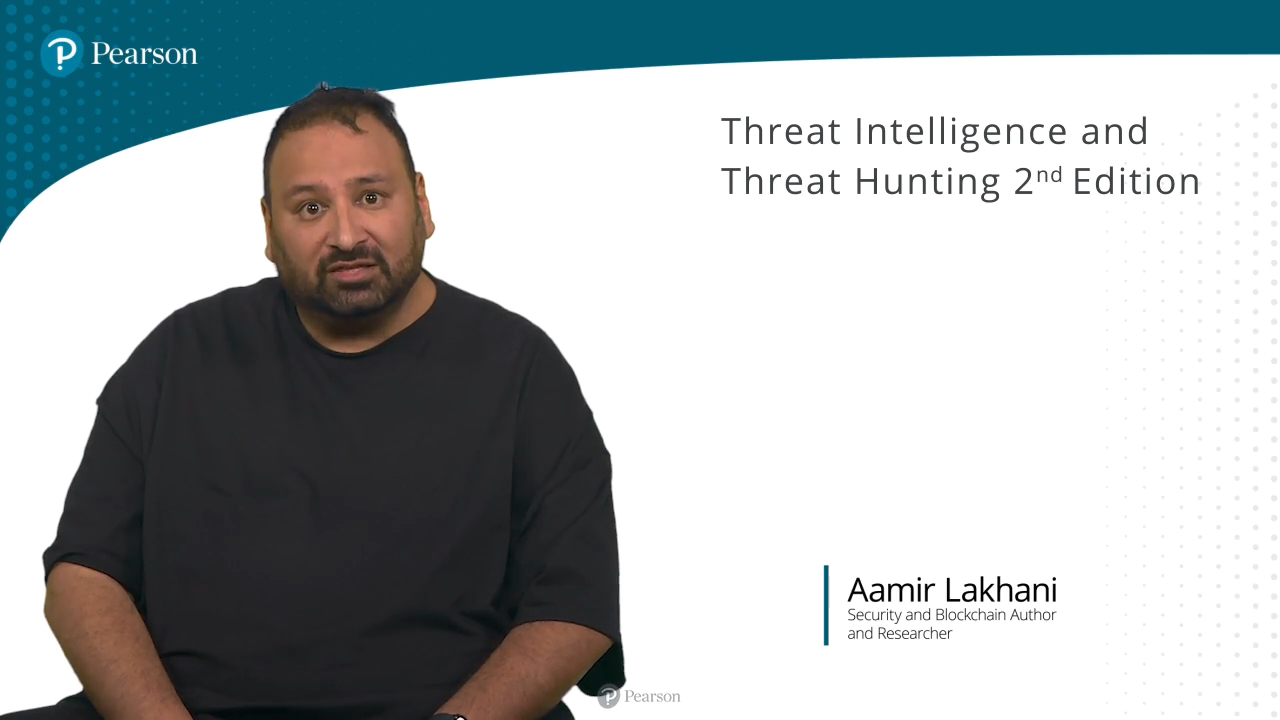Threat Intelligence and Threat Hunting 2nd Edition (Video Course)
- By Aamir Lakhani
- Published Apr 3, 2024 by Addison-Wesley Professional.
Online Video
- Your Price: $239.99
- List Price: $299.99
- About this video
Video accessible from your Account page after purchase.
Register your product to gain access to bonus material or receive a coupon.
Description
- Copyright 2024
- Edition: 1st
- Online Video
- ISBN-10: 0-13-534214-7
- ISBN-13: 978-0-13-534214-5
5 Hours of Video Instruction
Explore key threat intelligence and threat hunting concepts to help you protect your sensitive data.
A cybersecurity professional needs to understand threats, threat actors, and have a clear understanding of where attackers are trying to take advantage of vulnerabilities. The Threat Intelligence and Threat Hunting, 2nd Edition video course provides learners with the knowledge and skills to fortify systems, protect sensitive data, and ensure compliance with privacy regulations.
Throughout the course, expert trainer, author, and cybersecurity expert Aamir Lakhani uses hands-on demos, in-depth discussions and lightboard explanations to explore how to classify threats, work with the vulnerabilities, and use common assessment methodologies. By the end of this course, you will be able to protect sensitive data and ensure compliance with privacy regulations, secure systems and applications to prevent data exposure and advise your organization on privacy-by-design principles.
Topics include:
- Threat-Intelligence and Threat-Hunting Concepts
- Analyze Indicators of Potentially Malicious Activity
- Tools or Techniques to Determine Malicious Activity
- Concepts Related to Attack Methodology Frameworks
- Utilizing Threat Intelligence to Support Organization Security
- Analyze Output from Common Vulnerability Assessment Tools
- Threats and Vulnerabilities Associated with Specialized Technology
Skill Level:
- Beginner
Learn How To:
- Apply key threat intelligence and threat hunting concepts
- Understand and classify hot attacks are taking advantage of vulnerabilities
- Use common vulnerability assessment methodologies
- Understand threats against Internet of Things, real-operating systems, and cloud-based environments
Who Should Take This Course:
- Cybersecurity Professionals
- Anyone interested in learning cyber security fundamentals.
About Pearson Video Training:
Pearson publishes expert-led video tutorials covering a wide selection of technology topics designed to teach you the skills you need to succeed. These professional and personal technology videos feature world-leading author instructors published by your trusted technology brands: Addison-Wesley, Cisco Press, Pearson IT Certification, Prentice Hall, Sams, and Que Topics include: IT Certification, Network Security, Cisco Technology, Programming, Web Development, Mobile Development, and more. Learn more about Pearson Video training at http://www.informit.com/video.
Video Lessons are available for download for offline viewing within the streaming format. Look for the green arrow in each lesson.
Sample Content
Table of Contents
Lesson 1: Threat-Intelligence and Threat-Hunting Concepts
1.1 Threat actorsPart 1
1.2 Threat actorsPart 2
1.3 Confidence levels
1.4 Threat hunting
Lesson 2: Analyze Indicators of Potentially Malicious Activity
2.1 Network-related
2.2 Host-related
2.3 Application-related
2.4 Malicious Activity Indicators
Lesson 3: Tools or Techniques to Determine Malicious Activity
3.1 ToolsPart 1
3.2 ToolsPart 2
3.3 Common techniquesPart 1
3.4 Common techniquesPart 2
3.5 Common techniquesPart 3
3.6 Programming languages/scripting
Lesson 4: Concepts Related to Attack Methodology Frameworks
4.1 Cyber kill chains
4.2 Diamond Model of Intrusion Analysis
4.3 MITRE ATT&CKPart 1
4.4 MITRE ATT&CKPart 2
4.5 Open Source Security Testing Methodology Manual (OSS TMM)
4.6 OWASP Testing Guide
Lesson 5: Utilizing Threat Intelligence to Support Organization Security
5.1 Attack FrameworksPart 1
5.2 Attack FrameworksPart 2
5.3 Threat Research
5.4 Threat Modeling Methodologies and Threat Intelligence Sharing with Support Functions
5.5 Wireless Analysis Techniques
Lesson 6: Analyze Output from Common Vulnerability Assessment Tools
6.1 Understanding Results
6.2 Web Application Scanners
6.3 Infrastructure Vulnerability Scanner
6.4 Software Assessment Tools and Techniques
6.5 Wireless Assessment
6.6 Cloud Infrastructure Assessment
Lesson 7: Threats and Vulnerabilities Associated with Specialized Technology
7.1 Mobile
7.2 Internet of Things (IoT) and Embedded DevicesPart 1
7.3 Internet of Things (IoT) and Embedded DevicesPart 2
7.4 APTs
7.5 Embedded and Real-Time Operating Systems (RTOS)
7.6 SOC and FPGA
7.7 Physical Access Control
7.8 Building Automation Systems, Vehicles, and Drones
7.9 Industrial Control Systems (ICS) and Process Automation
7.10 Defending Critical Infrastructure
7.11 Supervisory Control and Data Acquisition (SCADA)Part 1
7.12 Supervisory Control and Data Acquisition (SCADA)Part 2
7.13 Verifications and Quality Controls
